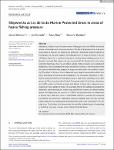Shipwrecks act as de facto Marine Protected Areas in areas of heavy fishing pressure
| dc.contributor.author | Hickman, J | |
| dc.contributor.author | Richards, J | |
| dc.contributor.author | Rees, A | |
| dc.contributor.author | Sheehan, EV | |
| dc.date.accessioned | 2024-04-24T16:03:07Z | |
| dc.date.available | 2024-04-24T16:03:07Z | |
| dc.date.issued | 2024-02 | |
| dc.identifier.issn | 0173-9565 | |
| dc.identifier.issn | 1439-0485 | |
| dc.identifier.other | ARTN e12782 | |
| dc.identifier.uri | https://pearl.plymouth.ac.uk/handle/10026.1/22320 | |
| dc.description.abstract |
Ubiquitous, industrial use of bottom‐towed fishing gear since the 1800s has altered marine communities and ecosystem services. Outside of legal protection, only areas inaccessible to trawlers are offered any protection. Shipwrecks present hazards to fishing gear and are rarely subject to trawling pressure. As many have been in situ for >100 years, they offer a baseline of ecological potential when trawling pressure is reduced or removed. Five shipwrecks were surveyed off the Berwickshire coast, some within the Static Gear Reserve and others outside. Video transects were collected of shipwrecks, the surrounding 50 m radius and control locations >150 m from the wreck site. Species identified were assigned a category based on their vulnerability to trawling. The effect of distance from a shipwreck on ecological communities within sites Open and Closed to trawling was investigated. The ecological importance of shipwrecks increased relative to trawling pressure. In Open sites, abundance was 340% greater on Wreck locations than Control. Conversely, within Closed sites, abundance was 149% greater in Control locations than Wreck. In Open sites, shipwreck communities are more similar to those in Closed sites, than to the habitat surrounding the shipwreck. Vulnerable species, mostly large, sessile filter feeders, are almost entirely absent from Open sites, but account for ~28% of the total abundance on shipwrecks in Closed sites. This study offers a quantifiable method to evaluate the ecological contribution of shipwrecks in disturbed areas and suggests their role may warrant further research, and consideration in conservation policy, such as inclusion in 30 × 30 objectives. Our findings also demonstrate the possible ecological gains of expanding or including static gear reserves across Marine Protected Areas. | |
| dc.language | en | |
| dc.publisher | Wiley | |
| dc.subject | horse mussels | |
| dc.subject | marine protected area | |
| dc.subject | OECM | |
| dc.subject | SAC | |
| dc.subject | Scotland | |
| dc.subject | shipwreck | |
| dc.subject | trawling | |
| dc.title | Shipwrecks act as de facto Marine Protected Areas in areas of heavy fishing pressure | |
| dc.type | Journal Article | |
| plymouth.issue | 1 | |
| plymouth.volume | 45 | |
| plymouth.publication-status | Published | |
| plymouth.journal | Marine Ecology | |
| dc.identifier.doi | 10.1111/maec.12782 | |
| plymouth.organisational-group | |Plymouth | |
| plymouth.organisational-group | |Plymouth|PRIMaRE Publications | |
| plymouth.organisational-group | |Plymouth|Faculty of Science and Engineering | |
| plymouth.organisational-group | |Plymouth|Faculty of Science and Engineering|School of Biological and Marine Sciences | |
| plymouth.organisational-group | |Plymouth|REF 2021 Researchers by UoA | |
| plymouth.organisational-group | |Plymouth|Users by role | |
| plymouth.organisational-group | |Plymouth|Users by role|Current Academic staff | |
| plymouth.organisational-group | |Plymouth|REF 2021 Researchers by UoA|UoA07 Earth Systems and Environmental Sciences | |
| plymouth.organisational-group | |Plymouth|REF 2029 Researchers by UoA | |
| plymouth.organisational-group | |Plymouth|REF 2029 Researchers by UoA|UoA07 Earth Systems and Environmental Sciences | |
| plymouth.organisational-group | |Plymouth|Users by role|Current Professional Services staff | |
| plymouth.organisational-group | |Plymouth|Users by role|Current Professional Services staff|Current PS AP&C | |
| plymouth.organisational-group | |Plymouth|Users by role|Current Visiting Scholars | |
| plymouth.organisational-group | |Plymouth|Users by role|Current Professional Services staff|Current PS and AL with outputs | |
| dc.date.updated | 2024-04-24T16:03:00Z | |
| dc.rights.embargodate | 2024-04-27 | |
| dc.identifier.eissn | 1439-0485 | |
| rioxxterms.versionofrecord | 10.1111/maec.12782 |


